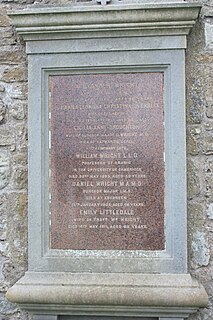
The Peshitta is the standard version of the Bible for churches in the Syriac tradition.
Joseph and Aseneth is a narrative that dates from before the 6th century CE. It seems to relate the romance, marriage and children of the Israelite patriarch Joseph and his Egyptian wife Asenath. Some have regarded it as a Jewish midrash or elaboration on the story in Genesis. Others question this interpretation partly because of its provenance, language, symbolism (Eucharistic) and covering letter which appear to indicate a Christian context.

Alphonse Mingana was an ethnic Assyrian theologian, historian, Syriacist, orientalist and a former priest who is best known for collecting and preserving the Mingana Collection of ancient Middle Eastern manuscripts at Birmingham. Like the majority of Assyrians in the Zakho region, his family belonged to the Chaldean Catholic Church. Alphonse was born to Paolus and Maryam Nano, and had seven siblings.

Prof William Wright LLD was a famous English Orientalist, and Professor of Arabic in the University of Cambridge. Many of his works on Syriac literature are still in print and of considerable scholarly value, especially the catalogues of the holdings of the British Library and Cambridge University Library. A Grammar of The Arabic Language, often simply known as Wright's Grammar, continues to be a popular book with students of Arabic. Wright is also remembered for the Short history of Syriac literature.

The British Library is the national library of the United Kingdom and the largest national library in the world by number of items catalogued. It is estimated to contain 150–200 million+ items from many countries. As a legal deposit library, the British Library receives copies of all books produced in the United Kingdom and Ireland, including a significant proportion of overseas titles distributed in the UK. The Library is a non-departmental public body sponsored by the Department for Culture, Media and Sport.

Syria played an important or even predominant role in the beginning of Christianity. Here is where the Gospel of Matthew, the Gospel of Luke, the Didache, Ignatiana, and the Gospel of Thomas were written. Syria was the country in which the Greek language intersected with the Syriac, which was closely related to the Aramaic dialect used by Jesus and the Apostles. That is why Syriac versions are highly esteemed by textual critics. Scholars have distinguished five or six different Syriac versions of all or part of the New Testament. It is possible that some translations have been lost. The Manuscripts originate in countries like Lebanon, Egypt (Sinai), Mesopotamia, Assyria, Armenia, Georgia, India, and even from China. This is good evidence for the great historical activity of the Syriac church.
Codex Phillipps 1388, Syriac manuscript of the New Testament, on parchment. It contains the text of the four Gospels. Palaeographically it had been assigned to the 5th/6th centuries. It is one of the oldest manuscripts of Peshitta with some Old Syriac readings.
British Library, Add. 14479, Syriac manuscript of the New Testament, on parchment. It is dated by a colophon to the year 534. It is one of the oldest manuscript of Peshitta and the earliest dated Peshitta Apostolos.
British Library, Add. 14455 is a Syriac manuscript of the New Testament, on parchment. Palaeographically it has been assigned to the 6th century. It is a manuscript of the Peshitta. The manuscript is very lacunose.
British Library, Add. 14459, Syriac manuscript of the New Testament, on a parchment. It is dated by a colophon to the year 528-529 or 537-538. It is one of the oldest manuscript of Peshitta and the earliest dated manuscript containing two of the Gospels in Syriac. The manuscript is bound with another dated to the 5th century.
British Library, Add. 14466 is a Syriac manuscript of the New Testament, according to Peshitta version, on parchment. Palaeographically it has been assigned to the 10 or 11th century.
British Library, Add. 14669, Syriac manuscript of the New Testament, according to the Peshitta version, on parchment. Palaeographically it has been assigned to the 6th century. It contains fragments of the Gospels.
British Library Manuscript, Add. 14448, designated by number 64 on the list of Wright, is a Syriac manuscript of the New Testament, on parchment, according to the Peshitta version. It is dated by a Colophon to the year 699 or 700. The manuscript is a lacunose. Gregory labelled it by 14e, 9a, and 8p . The codex is in the British Library as MS Add. 14448.
British Library, Add. Ms. 12150, is a Syriac manuscript of the writings of three ancient Christian authors: Clement of Rome, Titus of Bostra, and Eusebius of Caesarea.
British Library, MS. Add. 17124, designated by number 65 on the list of Wright, is a Syriac manuscript of the New Testament, according to Peshitta version, on parchment. Palaeographically it has been assigned to the 10th century. The manuscript is lacunose.
British Library, MS. Add. 12137, designated by number 75 on the list of Wright, is a Syriac manuscript of the New Testament, according to Peshitta version, on parchment. Palaeographically it has been assigned to the 6th or 7th century.
British Library, MS. Add. 14454, designated by number 87 on the list of Wright, is a Syriac manuscript of the New Testament, according to the Peshitta version, on parchment. Palaeographically it has been assigned to the 6th or 7th century.
The earliest extant copy of the Ecclesiastical History of Zacharias Rhetor is included in the late 6th century manuscript, British Library Manuscript #17,202. It has been published by Dr. Land under the title of Zachariae Ep. Mitylenes aliorumque scripta historica Graece plerumque deperdita.
The Mingana Collection of Middle Eastern manuscripts, comprising over 3,000 documents, is held by the University of Birmingham's Cadbury Research Library.







